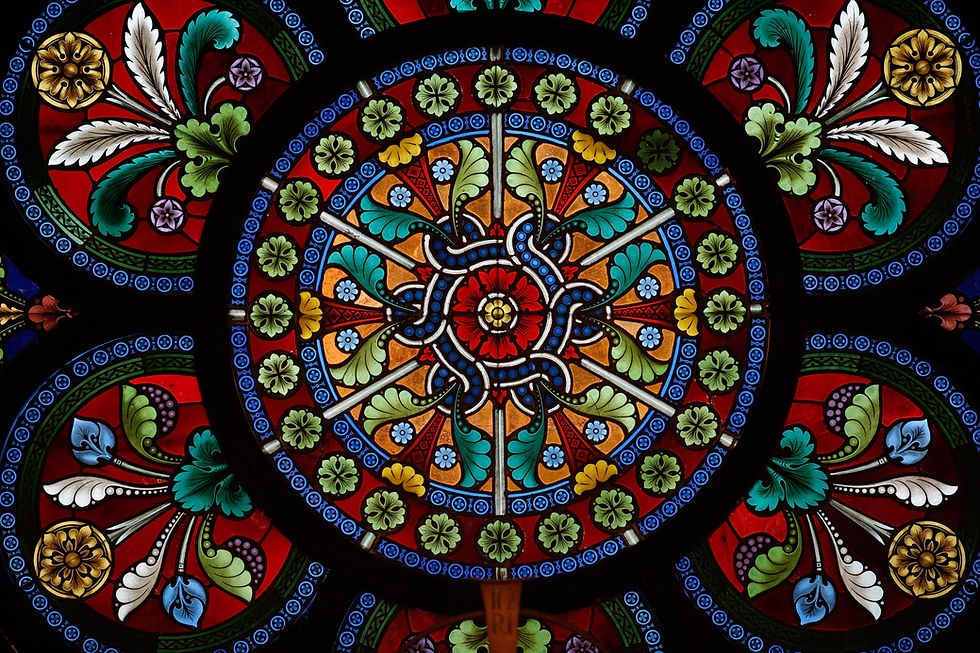The Power of the Mandala: Art, Healing, and Wholeness
- rebeccakrug1017
- Oct 12
- 3 min read

Mandalas have appeared across cultures for thousands of years — intricate circular designs that represent harmony, balance, and the interconnectedness of life. The word mandala comes from Sanskrit and means “circle,” but it’s more than a shape. It’s a mirror of the universe, a reflection of the self, and a meditative tool used by many traditions — from Buddhist monks creating sand mandalas to Indigenous peoples weaving dream catchers and medicine wheels.
A Brief History of Mandalas
In Hindu and Buddhist traditions, mandalas are sacred symbols of the cosmos — often used in meditation and ritual as a path toward enlightenment. Tibetan monks famously create elaborate mandalas from colored sand, spending days in focused devotion, only to sweep them away when complete — a profound reminder of impermanence.
In Native American and Celtic art, circular motifs appear as medicine wheels and sacred knots, symbolizing cycles, seasons, and connection between body, mind, and spirit. Across cultures, the mandala shows up where humans seek to understand their place in the world.
Carl Jung and the Psychology of the Mandalas
Swiss psychiatrist Carl Jung was one of the first Western thinkers to recognize the psychological significance of mandalas. He discovered them spontaneously appearing in his patients’ drawings — and in his own. Jung saw mandalas as expressions of the Self, representing the psyche’s natural drive toward balance, order, and wholeness.
He wrote: “The mandala is the psychological expression of the totality of the self.”
When people draw or color mandalas, they’re often externalizing an internal state — creating a map of their inner world. Jung used mandala-making as a form of active imagination, helping clients integrate unconscious material and move toward psychological integration — what he called individuation.
The Healing Power of Mandalas
Creating or observing mandalas can have calming, restorative effects on the nervous system. The symmetry and repetition encourage mindfulness, slowing racing thoughts and activating the parasympathetic nervous system — the body’s natural “rest and restore” state.
Modern research supports this:
- A study in Art Therapy: Journal of the American Art Therapy Association found that coloring within circular mandala patterns reduced anxiety significantly more than free-form drawing or coloring other shapes (Curry & Kasser, 2005).- Mandala-making has been used in trauma therapy, stress reduction, and mindfulness-based art interventions, helping clients regulate emotion and reconnect to a sense of safety and order.
The circular form itself is symbolic of unity and continuity — without beginning or end — which can offer comfort in times of chaos or loss. Mandalas remind us that healing is not a straight line, but a spiral — one that returns us, again and again, to our center.
Mandalas in Therapeutic Arts Practice:
In therapeutic arts, mandalas can be both diagnostic and restorative. The colors, shapes, and balance often reflect emotional states. For some, creating mandalas offers a nonverbal language for grief or trauma; for others, it’s a grounding ritual, a way to connect with presence and peace. When clients create mandalas in my own practice, I notice how the simple act of working within a circle creates a sense of containment and safety. It’s both boundary and invitation — holding what’s too hard to name and turning it into something beautiful, meaningful, and whole.
🌿 A Simple Practice: Create Your Own Mandala
1. Find a quiet space and take a few deep breaths.
2. Begin with a circle — on paper, in sand, or digitally.
3. Let your intuition guide the design — shapes, lines, colors. There’s no right or wrong.
4. Focus on your breath and rhythm, not the result.
5. When finished, take a moment to reflect: What does this pattern reveal about what I need right now?
Creating mandalas invites stillness and presence. They remind us that even in complexity, beauty emerges through balance.
-My best- Rebecca
References
Curry, N. A., & Kasser, T. (2005). Can coloring mandalas reduce anxiety? Art Therapy: Journal of the American Art Therapy Association, 22(2), 81–85.
Jung, C. G. (1968). Man and His Symbols. London: Aldus Books.
Jung, C. G. (1950). The Archetypes and the Collective Unconscious. Princeton University Press.




Comments